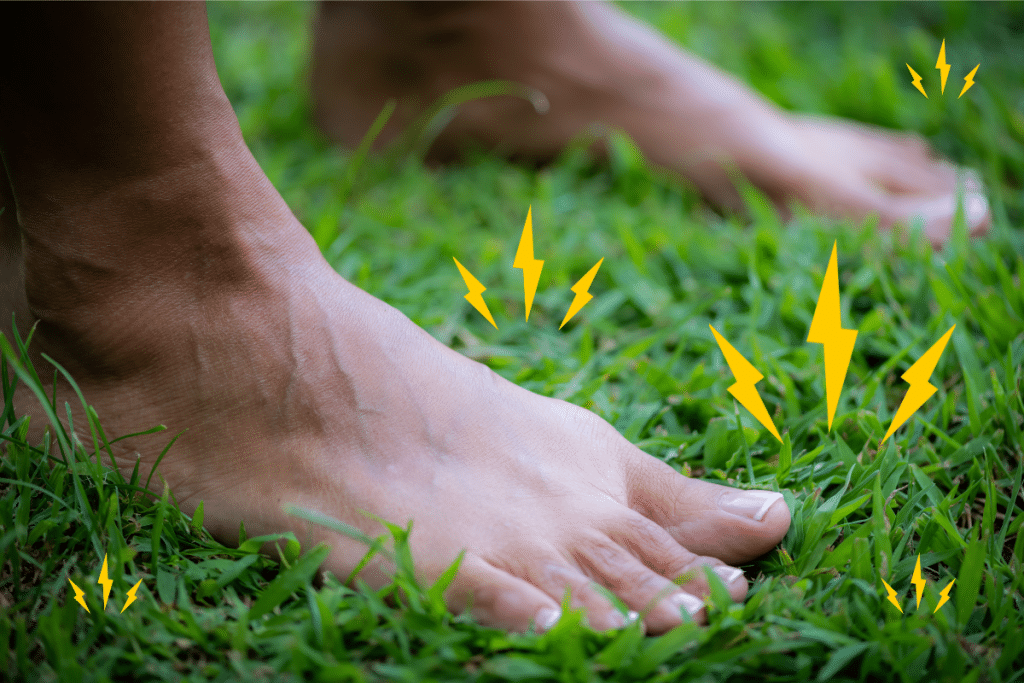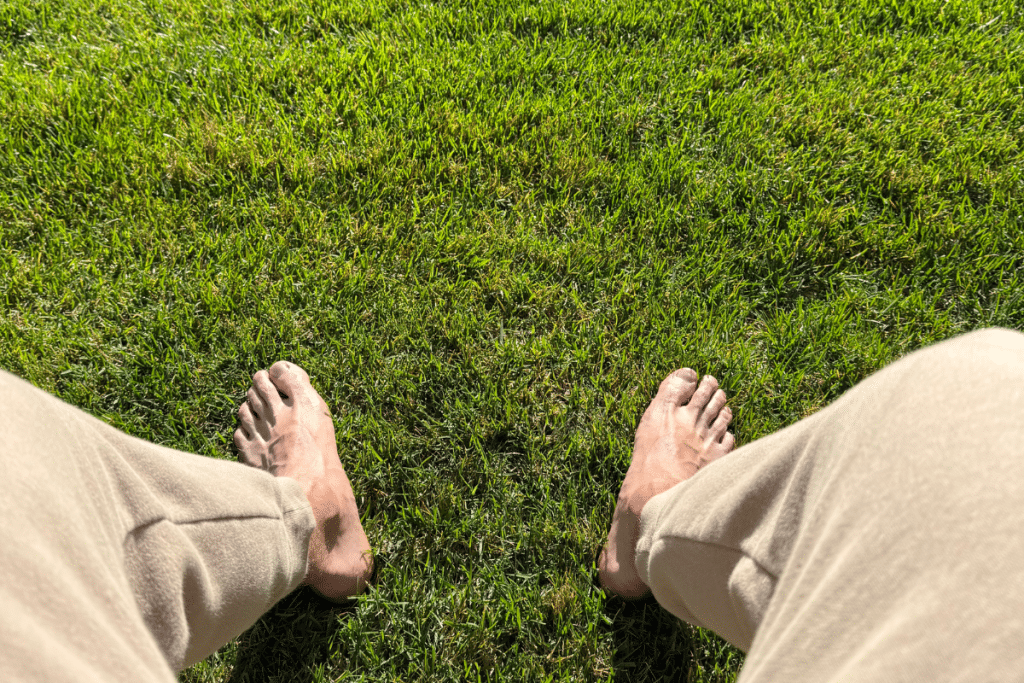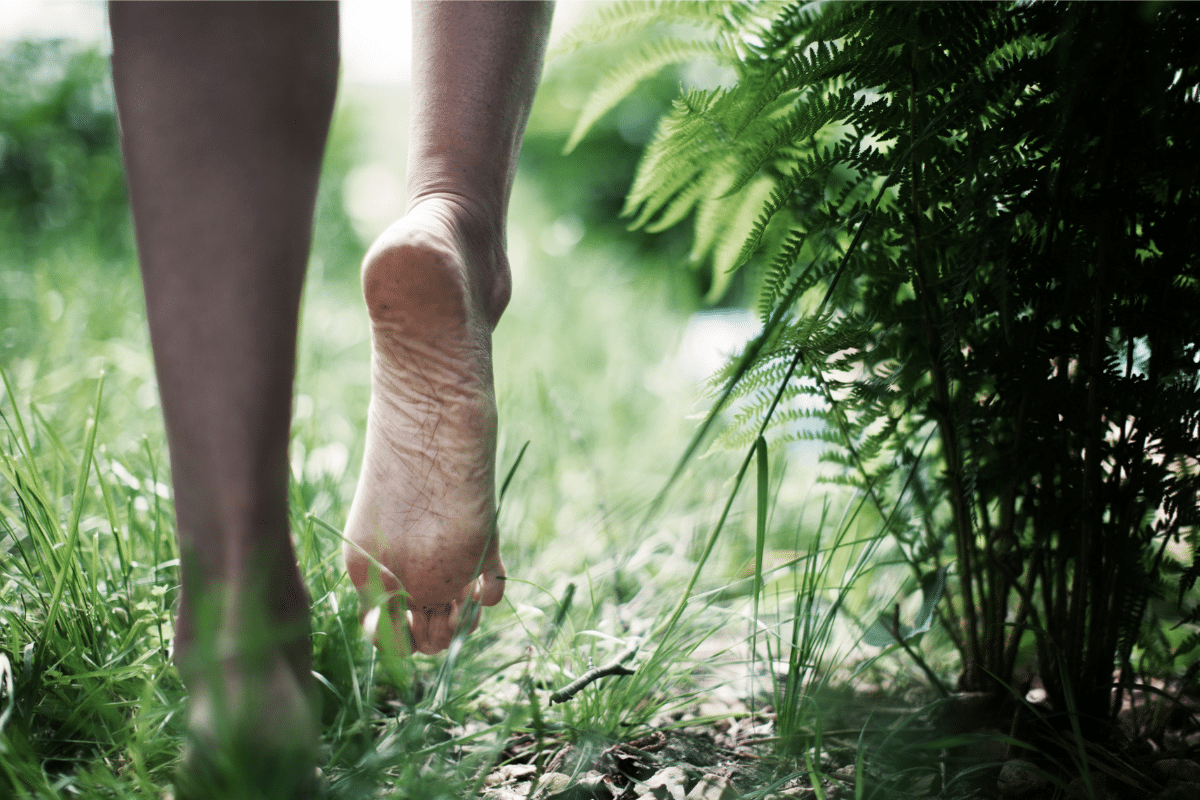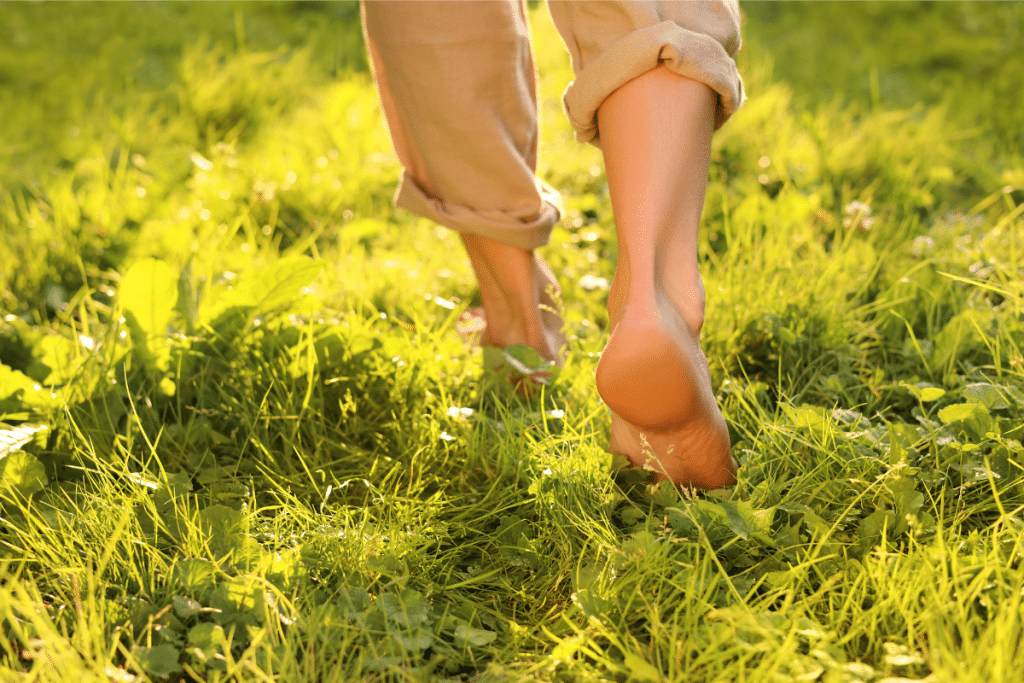Grounding: Transform Your Health With Earth’s Natural Energy
Did you know that simply walking barefoot on the Earth can boost your health in powerful ways? Science backs it, and the benefits might surprise you! Grounding, also known as earthing, has gained significant scientific attention recently. Research found that grounding can begin to reduce inflammation within just 30 minutes of direct Earth contact. I’ve personally experienced the remarkable difference grounding has made in my sleep quality and stress levels.

In this comprehensive guide, we’ll explore what grounding is, how it works, and the impressive array of health benefits it offers. Whether you’re dealing with chronic pain, sleep issues, or looking for natural ways to enhance your well-being, grounding might be the missing piece in your health puzzle!
What Is Grounding? How It Works and Why It Matters
Grounding, also known as earthing, is the practice of making direct physical contact with the Earth’s surface. This simple act involves walking barefoot on soil, grass, and sand or even swimming in natural bodies of water like oceans, lakes, or rivers.

At its core, grounding works because of the Earth’s natural electrical properties. The Earth maintains a negative electrical charge and continuously produces free electrons. When humans make direct skin contact with the ground, these electrons can transfer from the Earth’s surface into the human body, creating a kind of electrical equilibrium between the body and the Earth.

The human body functions as an electrical system. Every cell operates through electrical impulses, and the nervous system communicates via electrical signals. When we connect directly with the Earth, we essentially “recharge” with its natural electrical energy, which helps stabilize our internal bioelectrical environment.
Modern lifestyle has significantly disconnected humans from this natural resource. Most people wear shoes with synthetic rubber or plastic soles, which act as insulators and block the flow of electrons from the ground. Additionally, we spend approximately 90% of our time indoors, living and working in buildings that separate us from direct Earth contact.
- The electrical conductivity between the Earth and human body is strongest when skin directly interacts with natural surfaces.
- Moist skin and damp ground create even better conductivity conditions for electron transfer.
- Even brief periods of grounding (20-30 minutes) can begin to affect various biological markers.
Interestingly, many traditional cultures inherently practiced grounding throughout human history. From indigenous peoples who lived barefoot or wore natural leather footwear to traditional societies that slept on the ground, this connection to Earth was once ubiquitous. Today’s scientific understanding of electrical conductivity, free radical biology, and the Earth’s electrical properties provides a framework for intuitively understanding what these cultures experienced.

Modern research has begun quantifying these effects, showing that grounding may influence inflammation levels, sleep quality, pain perception, and other physiological processes. The convergence of traditional wisdom and contemporary scientific understanding represents a fascinating rediscovery of one of nature’s most basic health principles.
The History and Evolution of Grounding Practices

Grounding practices have deep historical roots across numerous indigenous cultures worldwide. Native American traditions often included barefoot ceremonies to honor and connect with the Earth. At the same time, many Aboriginal communities in Australia practiced “earthing” by maintaining direct skin contact with the land during spiritual rituals and daily activities. In ancient India, yogic practices emphasized connecting to the Earth’s energy, with many meditation postures specifically designed to create a direct channel between the practitioner and the ground.

Throughout history, humans naturally maintained this Earth connection simply through lifestyle. Before the widespread use of synthetic footwear, people typically walked barefoot or wore shoes made from natural materials like leather that allowed some electrical conductivity. Traditional sleeping arrangements in many cultures involved resting directly on the ground or on minimally insulating natural materials, maintaining the body’s electrical connection to Earth throughout the night.
The modern rediscovery of grounding began in earnest during the late 1990s when Clint Ober, a retired cable TV executive, made a crucial observation about electrical grounding principles. Ober noticed that humans had become increasingly insulated from the Earth through synthetic-soled shoes and elevated living spaces, potentially disrupting our natural electrical state. This insight led him to conduct informal experiments with grounding, eventually sparking interest in the scientific community.
The first formal research studies on grounding were conducted in the early 2000s. In 2004, the Journal of Alternative and Complementary Medicine published one of the first peer-reviewed studies examining grounding’s effects on sleep quality and cortisol levels. The research found significant improvements in both areas, helping to legitimize what had previously been considered fringe science.
- The 2010 publication “Earthing: The Most Important Health Discovery Ever?” by Ober, Sinatra, and Zucker helped popularize grounding concepts
- Between 2010-2020, over two dozen peer-reviewed studies on grounding were published.
- Research expanded to examine effects on inflammation, immune response, and cardiovascular health.
Grounding practices evolved significantly as research validated their benefits. What began as simple barefoot walking expanded to include specialized equipment designed to recreate Earth connection even indoors. Grounding mats, sheets, bands, and patches emerged to help people maintain electrical contact with the Earth while sleeping, working, or recovering from injury.
The irony of technological advancement in grounding is notable. Technology also provided new solutions as our electronic world increasingly separated us from natural Earth contact. Modern grounding products often utilize conductive materials connected to the ground port of electrical outlets or directly to the Earth through grounding rods, creating convenient ways to maintain Earth connection despite urban lifestyles.

Key figures in the grounding movement include Clint Ober and cardiologist Dr. Stephen Sinatra, who helped bring credibility to grounding research within the medical community. Biophysicist James Oschman contributed significantly to understanding the electromagnetic aspects of grounding, while researcher Gaétan Chevalier has conducted numerous studies demonstrating measurable physiological changes from grounding practices.
As environmental health concerns grow and interest in ancestral practices increases, grounding continues to gain recognition as both an ancient wisdom and a scientifically validated health practice. The evolution of grounding from indigenous tradition to modern wellness strategy represents a fascinating convergence of historical knowledge and contemporary science, offering a simple yet powerful way to reconnect with one of nature’s most fundamental resources.
7 Science-Backed Health Benefits of Grounding
Grounding continues to gain scientific validation as researchers uncover its wide-ranging health benefits. Recent studies have demonstrated several measurable physiological effects when reconnecting with the Earth’s electrical field. Here’s what the latest research shows about grounding’s impact on health.
- Inflammation reduction is perhaps the most well-documented benefit of grounding:
Multiple clinical studies show direct Earth contact significantly decreases inflammatory markers. To further boost these benefits, consider combining grounding with a diet rich in anti-inflammatory foods.

- Multiple clinical studies show direct Earth contact significantly decreases inflammatory markers
- A 2023 Study analyzed 12 separate studies, finding consistent reductions in key inflammatory biomarkers
- Chronic pain sufferers often experience a 30-40% reduction in pain scores after grounding for 30+ minutes daily
2. Sleep quality improvements are another significant benefit backed by compelling research:
- A 2015 study found that grounding helped people fall asleep faster and improved overall sleep quality.
- Morning energy levels increased significantly, with benefits typically appearing after 1-2 weeks
3. Stress reduction occurs through multiple mechanisms when grounding:

- Studies show normalized cortisol rhythms within 8 weeks of regular practice
- Research indicates grounding activates the parasympathetic nervous system
- Heart rate variability studies show improved autonomic nervous system function after just 30 minutes
4. Immune function enhancement appears to stem from grounding’s effects on inflammatory pathways:
- Better Immune Response – Grounding may help balance the immune system, making it more efficient at fighting off infections.
- Fewer Seasonal Illnesses – Many people who practice regular grounding report experiencing fewer colds, flu, and other common illnesses throughout the year.
5. Cardiovascular improvements from grounding include better blood viscosity and flow:

- Research documents decreased blood thickness and reduced clumping of red blood cells
- A 2023 thermography study showed significantly improved circulation to extremities within 30 minutes
- Benefits for vascular health and blood pressure regulation continue for 24-48 hours after grounding
6. Wound healing acceleration has been observed in several clinical trials:
- Earth’s free electrons may neutralize positively charged free radicals that impede healing
- A 2021 study found surgical wounds healed 27% faster in patients using grounding patches
- Reduced inflammation and improved circulation likely contribute to enhanced healing rates
7. Mental health benefits, including reduced anxiety and depression symptoms:

- A 2024 pilot study found significant improvements with 40 minutes of daily grounding for six weeks
- Participants experienced a 41% reduction in anxiety scores and 38% improvement in depression measures
- Effects were most pronounced when grounding occurred outdoors in natural settings
As research continues to expand in 2025, these seven key benefits represent just the beginning of our understanding of how reconnecting with the Earth’s electrical field may support human health.
⚡ Want to experience these benefits firsthand?
👉 Grab my FREE 3-Day Life Reset Plan it’s designed to help you reconnect with nature, reduce stress, and boost energy
How to Practice Grounding: 5 Simple Techniques Anyone Can Try
Incorporating grounding into your daily routine doesn’t require expensive equipment or massive lifestyle changes. Here are five effective and accessible techniques to help you reconnect with the Earth’s energy:

Walking barefoot on natural surfaces is the simplest and most direct form of grounding. Grass, sand, soil, and even unsealed concrete all effectively conduct the Earth’s electrons. For optimal benefits, aim for at least 20-30 minutes of barefoot contact daily, with moist surfaces like morning dew-covered grass or damp beach sand providing enhanced conductivity.
- Start with short periods if you’re not used to being barefoot and gradually increase the duration as your feet adapt
- Try early morning walks on dewy grass for maximum conductivity and before the ground becomes too hot in summer
Swimming in natural bodies of water offers full-body grounding contact through highly conductive environments. Oceans, lakes, rivers, and streams are all excellent grounding options, with salt water being particularly effective due to its mineral content. The combination of water immersion and grounding creates a powerful relaxation effect on the nervous system. Even wading or sitting with your feet in natural water provides significant benefits if swimming isn’t possible.
Using grounding mats and sheets brings the Earth’s energy indoors, making it accessible regardless of weather or living situation. These specially designed products connect to the ground port of electrical outlets or directly to the Earth through grounding rods. Grounding mats can be placed under your desk for workday grounding, while conductive sheets and pillowcases allow for 7-8 hours of grounding during sleep. Look for products that have undergone third-party testing for safety and conductivity.

Gardening with bare hands and feet combines grounding with other health benefits such as light exercise, vitamin D exposure, and psychological well-being. Direct contact with soil while planting, weeding, or harvesting creates a strong Earth connection. Even tending to a small container garden on a balcony can provide grounding opportunities. Working with damp soil enhances electrical conductivity and grounding effectiveness.
- The combination of soil microbes and Earth’s energy makes gardening a particularly powerful grounding practice
- Research suggests even 10 minutes of barefoot gardening can reduce stress hormone levels
Practicing grounding meditation and mindfulness enhances the mental benefits of Earth connection. Find a natural outdoor setting and sit or stand with direct Earth contact, focusing your attention on the sensation of connection between your body and the ground. Visualize the Earth’s energy flowing up through your feet or body, and pair deep breathing exercises with your grounding practice to amplify relaxation effects.
Tips for urban dwellers to find grounding opportunities in concrete jungles: City parks, especially those with natural areas, offer accessible grounding spaces throughout urban environments. Beach visits provide excellent grounding surfaces through sand and ocean water. Community gardens or rooftop green spaces can serve as urban grounding spots, while indoor grounding products like mats and sheets are particularly valuable for apartment dwellers.
Remember that consistency is more important than duration. Regular short grounding sessions provide more benefit than occasional long ones. Start with whatever method fits most easily into your current lifestyle, and consider experimenting with different techniques to discover what works best for your body and schedule.
Conclusion
Connecting with the Earth through grounding is more than just a wellness trend. It’s a return to a fundamental human experience that modern lifestyles have largely eliminated. The science is compelling: grounding offers measurable benefits for inflammation, sleep, stress, and overall well-being. As we’ve explored, implementing this practice doesn’t require expensive equipment or significant lifestyle changes; simply stepping outside barefoot can begin your grounding journey!

I encourage you to experiment with our discussed techniques and pay attention to how your body responds. Remember, consistent practice yields the best results. In a world where we’re increasingly disconnected from nature, grounding provides a simple, accessible way to reclaim our connection to the Earth and transform our health.
🌿 Ready to reclaim your energy and reconnect with nature?
👉 Start with my FREE 3-Day Life Reset Plan it’s a quick, powerful guide that pairs perfectly with your grounding practice. Feel the shift in focus, mood, and vitality in just 3 days.
Note: This guide is for informational purposes only. Always consult with healthcare professionals before making significant dietary changes or starting new supplement regimens.






